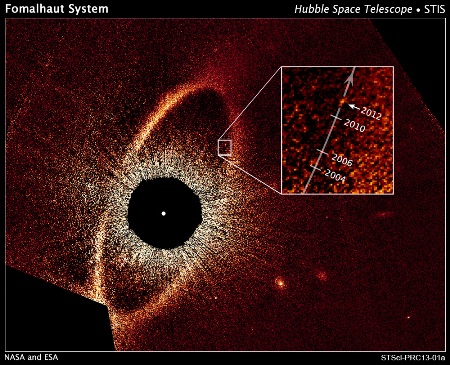Jan 9 2013
Newly released Hubble Space Telescope images of a vast debris disk encircling the nearby star Fomalhaut, and of a mysterious planet circling it, may provide forensic evidence of a titanic planetary disruption in the system.
 Rogue Planetary Orbit for Fomalhaut b This false-color composite image, taken with the Hubble Space Telescope, reveals the orbital motion of the planet Fomalhaut b. Based on these observations, astronomers calculated that the planet is in a 2,000-year-long, highly elliptical orbit. Credit: NASA, ESA, and P. Kalas (University of California, Berkeley and SETI Institute)
Rogue Planetary Orbit for Fomalhaut b This false-color composite image, taken with the Hubble Space Telescope, reveals the orbital motion of the planet Fomalhaut b. Based on these observations, astronomers calculated that the planet is in a 2,000-year-long, highly elliptical orbit. Credit: NASA, ESA, and P. Kalas (University of California, Berkeley and SETI Institute)
Astronomers are surprised to find that the debris belt is wider than previously known, spanning a gulf of space from 14 billion miles to nearly 20 billion miles from the star. Even more surprisingly, the latest Hubble images have allowed a team of astronomers to calculate that the planet follows an unusual elliptical orbit that carries it on a potentially destructive path through the vast dust ring.
The planet, called Fomalhaut b, swings as close to its star as 4.6 billion miles, and the outermost point of its orbit is 27 billion miles away from the star. The orbit was re-calculated from the newest Hubble observation made in 2012. "We are shocked -- Fomalhaut b probably passed three times closer to the star than we previously thought, and now it is zipping outward," said Paul Kalas of the University of California at Berkeley and the SETI Institute in Mountain View, Calif.
The Fomalhaut team led by Kalas considers this circumstantial evidence that there may be other planet-like bodies in the system that gravitationally disturbed Fomalhaut b to place it in such a highly eccentric orbit.
His team is presenting their finding on January 8 at the 221st meeting of the American Astronomical Society in Long Beach, Calif.
Among several scenarios to explain Fomalhaut b's 2,000-year-long orbit is the hypothesis that an as yet undiscovered planet gravitationally ejected Fomalhaut b from a position closer to the star, and sent it flying into an orbit that extends beyond the dust belt. "Hot Jupiters get tossed through scattering events, where one planet goes in and one gets thrown out. This could be the planet that gets thrown out," according to co-investigator Mark Clampin of NASA's Goddard Space Flight Center in Greenbelt, Md.
Hubble also found that the dust and ice belt encircling Fomalhaut (the star) has an apparent gap slicing across the belt. This might have been carved out by another undetected planet, researchers said. "Hubble's exquisite view of the dust belt shows irregularities that strongly motivate a search for other planets in the system," Kalas said.
"If its orbit lies in the same plane with the dust belt, then Fomalhaut b will intersect the belt around 2032 on the outbound leg of its orbit. During the crossing, icy and rocky debris in the belt could crash into the planet's atmosphere and create the type of cosmic fireworks seen when comet Shoemaker-Levy 9 crashed into Jupiter," Kalas said. "But if Fomalhaut b is not co-planar with the belt, we may not see anything at all except for a gradual dimming of Fomalhaut b as it travels farther and farther from the star," he explained.
Kalas hypothesized that Fomalhaut b's extreme orbit is a major clue in explaining why the planet is unusually bright in visible light but very dim in infrared light. The planet could be between the mass of Pluto and Jupiter, but the optical brightness possibly originates from a ring or shroud of dust around the planet, reflecting starlight. The dust is rapidly produced by satellites orbiting the planet, which suffer extreme erosion by impacts and gravitational stirring when Fomalhaut b enters into the planetary system after a millennium of deep freeze beyond the main belt. "An analogy can be found by looking at Saturn, which has a tenuous but very large dust ring produced when meteoroids hit the outer moon called Phoebe," Kalas said.
The team has also considered a different scenario where a hypothetical second dwarf planet suffered a catastrophic collision with Fomalhaut b. Kalas explained, "The collision scenario would provide a solution as to why Fomalhaut (the star) has a narrow outer belt linked to an extreme planet. But in this case the belt is young, less than 10,000 years old, and it is difficult to produce energetic collisions far from the star in such young systems."
Two previous papers have confirmed Fomalhaut b's existence as derived in the previous Hubble observations.
"Fomalhaut is a rather special system because it looks like we have a snapshot of what our solar system was doing 4 billion years ago," Kalas said. "The planetary architecture is being redrawn, the comet belts are evolving, and planets may be gaining and losing their moons." Astronomers will continue monitoring Fomalhaut b for decades to come because they may have a chance to observe a planet entering an icy debris belt that is like the Kuiper Belt at the fringe of our own solar system.